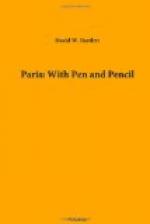The best thing I know about the Luxembourg palace is, that it has a gallery of paintings. It formerly was used to exhibit paintings by the old masters, but now nothing is allowed a place in the Luxembourg gallery but pictures of living artists. As soon as the artist dies, his pictures which hang in the Luxembourg, and which have been purchased by the government, are at once removed to the Louvre, where only paintings of men now dead are on exhibition.
The collection in the Luxembourg is in many respects a very fine one, but it has the fault of all the modern French and continental pictures—there is too much sensuality exhibited upon the canvas. The school is too voluptuous—too licentious. I can put up with anything not positively indecent for the sake of art, but I cannot put up with French pictures. Their nakedness is too disgusting, for it is not relieved by sentiment, unless of the basest kind. This remark of course does not apply to all the pictures I saw. Some of them are very fine, especially those of Delaroche and the war pictures of Horace Vernet. Near the entrance there is a beautiful group by Delaistre, representing Cupid and Psyche.
One of the pictures in this gallery haunts me still. It is an illustration of one of Dante’s immortal verses—his visit to the lake of Brimstone. The poet with a wreath of laurel round his brow stands in the center of a little boat, while his conductor in the stream propels the craft with one oar over the boiling and surging sea of hell. His countenance is filled with mingled astonishment and horror, yet he preserves his wits and observes very critically all that is about him. One poor wretch lifts his head from the liquid fire, and fastens his jaws upon the rim of the boat in his terrible agony, while one of the attendants of the boat with an oar endeavors to beat him back. On the other side a ghostly wretch has fastened his long teeth into a fellow-sufferer. The shades of light and darkness are so mingled that the effect is very striking. It is the most horrible picture I ever looked at, and I would much rather sleep in Madame Tassaud’s chamber of horrors, than look at it again. In the next apartment there is a picture of Christ, which struck me as the best I ever looked at. The divine sweetness of the human and the grandeur of the God were united with wonderful skill. The face was half-sorrowful, as if the heart were filled with thoughts of a sinful, suffering world, and still upon the brow the very sunshine of heaven rested. The impression which that face made upon me will never be entirely obliterated, and its effect was far different from the illustration of Dante. The two pictures, it seemed to me, teach a useful lesson. It is that men are to be saved through love, and not through fear. Let men see God’s beauty and loveliness, and you will more surely win them from error than by showing them the horrors of hell.




